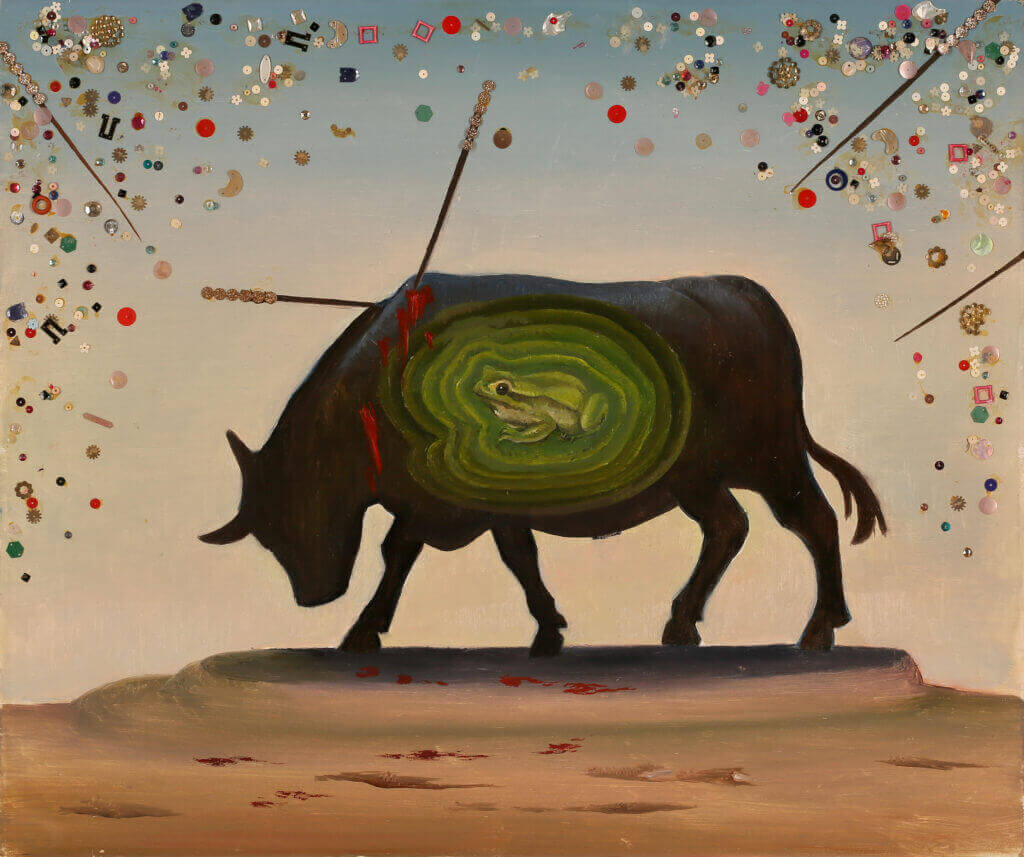Your currently viewing RAW Modern | Switch to RAW Contemporary
Eloge de la Folie, 1971
L’éloge de la Folie is a heavily symbolic work which is undoubtedly named after ‘The Praise of Folly’, an essay written in Latin in 1509 by Desiderius Erasmus of Rotterdam and first printed in June 1511. This work played a vital role at the beginning of the Protestant Reformation and serves as a satirical examination of pious but superstitious abuses of Catholic doctrine and corrupt practices in parts of the Roman Catholic Church and its political allies.
The imagery of Graverol’s painting is clearly inspired by The Frog and the Ox, which appears among the ancient Greek slave and storyteller Aesop’s Fables(620-564 BCE) and is numbered 376 in the Perry Index. The story concerns a frog that tries to inflate itself to the size of an ox but bursts in the attempt. In 1688, Jean de la Fontaîne (1621-1695), inspired by Aesop, wrote his own version entitled: ‘The two Bulls and the Frog’, which recounts the fear of a frog who comes face-to-face with two bulls fighting over a heifer; the fable brings together opposing animals, one weak and one powerful, which evokes the imbalance of the power dynamics between the church, royalty, aristocracy and the ‘common’ people:
“This world of ours is full of foolish creatures too –
Commoners want to build chateaux.
Each princeling wants his royal retinue.
Each count his squires. And so it goes.”
The frog inside the Bull’s stomach has been identified as a Bull Frog, which gets its name from the sound that males make during the breeding season, which can resemble the bellowing of a bull. A highly invasive and destructive species, they were introduced to France in the 1960s by a collector who wanted to have them in a pond as a curiosity. Escaping into the wild and spreading throughout Western Europe at a highly alarming rate due to having no predators, as opposed to their native North America where they are eaten by alligators, by the 1970s they had completely taken over wetlands around the Gironde and Dordogne rivers damaging native wildlife. Failed eradication attempts were recorded in 2003 and 2007.
Graverol’s humorous reinterpretation of Aesop’s & De la Fontaîne’s fables reiterates powerful socio-political dynamics but with one main difference: Graverol’s bull, representing wealth, royalty and the church, has eaten the frog, representing the people. The bull, however, is being killed with picas, reminiscent of Spanish and Southern French Feria celebrations, indicating a revolution. The ‘jewels’ which adorn the top of the painting might also symbolise the wealth and prosperity of royalty and the church.
Animals are a recurring theme in Graverol’s work. While the theme of the half-man, half-machine was adopted by many surrealists as a tool for denouncing the effects of industrialisation on mankind, in paintings such as The Holy Spirit (1965) and The School of Vanity (1967), Graverol applies this juxtaposition to the animal world. Particularly during her later life, Graverol dedicated much of her time to issues of war and its impact on humanity and socio-political issues. This work, while highly surrealist, does not use the automatic techniques promoted by Breton, but instead uses heightened realism to create a dream-like dystopia centring on the animal kingdom as a way of explicitly highlighting hierarchical power dynamics and violence in which the ‘weakest’ people are ‘being eaten’ or ‘swallowed up’.

